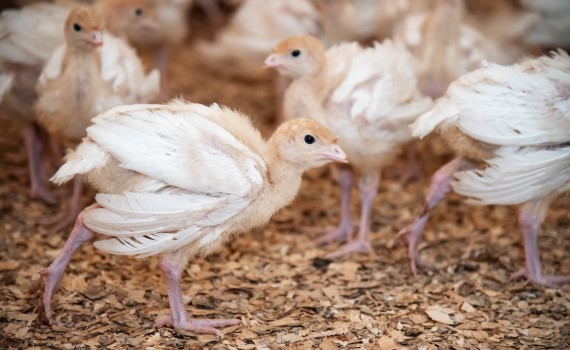Incubation key to preventing leg problems in turkey poults
Excessive heat and humidity during incubation can cause leg problems in turkey poults, ultimately leading to higher hatchery costs mainly due to an increase in the percentage of culls, according to a hatchery expert.
Juan Carlos Lopez, DVM, PhD, hatchery specialist with Hendrix Genetics said leg problems such as red hocks, splayed legs and crooked toes are usually caused by excessive heat or humidity in the setter.
High heat also affects the amount of yolk poults absorb, which has consequences during the first week the poults are on the farm, he told Poultry Health Today.
Leg problems stemming from excessive incubation temperatures can result in a 3% to 4% culling rate, compared to the normal 1% to 2% culling rate in a typical turkey hatchery, Lopez said.
Ideal 7-day mortality is less than 1% on the farm, but problems from excessive heat and humidity may push that mortality to as much as 4%, he said.
If the birds with leg alterations are separated out at hatch, there should be no major problems on the farm, Lopez said.
Too hot to handle
From day 1 to 25 of incubation, turkey eggshell temperature should be between 99.4° F and 100° F (37.4° C to 37.7° C), Lopez said.
Because not all hatching eggs are the same, incubation temperature profiles have to be adjusted; eggs from older hens have bigger yolks, which produce more heat than eggs from younger hens.
Heat can be used during incubation to speed up or slow down the hatch, and higher temperatures may improve hatchability. However, when temperatures are too high, they cause an imbalance in the thyroid gland of the embryo, leading to uneven absorption of the yolk and, ultimately, leg problems, he explained.1
When poults don’t absorb the yolk completely, the extra amount of yolk inside their bodies causes poor appetite, and the poults won’t eat or drink on the farm, resulting in their deaths a few days later.2
In the setter, turkey eggs should lose 11% to 12% of their original weight, creating an air cell space big enough for the poult to break the shell and get out. High humidity levels during incubation create a smaller air cell, which results in poults injuring their hocks when they break out, Lopez said.
Good hatchery management
Hatchery managers have many tools available to achieve optimum eggshell temperatures, especially in multi-stage incubators.
They can avoid placing eggs on the highest shelf in the setter. Fewer eggs can be placed in each tray, and eggs can be removed from the setter at day 22, versus day 25, if they are getting too hot, he said.
Lopez emphasized that the hatch window must be correct: 36 hours before the scheduled pulling time, between 1% to 3% of the poults — but not more than 5% — should have hatched. That indicates the temperature profile is correct.
If more than 25% of the poults have hatched 36 hours before the scheduled pulling time, however, that spells trouble, he said. Those poults will be small due to dehydration, and the flock will not be uniform, since the later-hatching poults will be heavier.
Another useful tool is calculating poult yield, which indicates how the incubation process is going, Lopez said.
Starting with an egg that’s 100 grams, for example, the newly hatched poult should be 67% to 68% of the original weight. If the poults weigh 63% to 64% of the egg weight, they’ve been out too long, either because of high temperatures or wrong calculation of the incubation time.
All these tools — eggshell temperature, moisture loss at transfer, hatch window and poult yield — give the hatchery manager the ability to ensure that the correct hatching temperatures, humidity and ventilation are being used, he said.
Poult survival on the farm
Turkey poults aren’t as motivated as broiler or layer chicks are to find food or water once they’re on the farm, Lopez explained, so food and water need to be easy for poults to access.
Some companies put the feed on paper, which makes noise when poults walk on it and encourages poults to peck at the paper. Poults that eat soon after arrival at the farm can develop robust digestive and immune systems, he added.
At placement on the farm, the poults’ cloacal temperature needs to be 103° F to 104° F (39.4° C to 40° C), which is a comfortable temperature for poults.
If they are warm, they’ll look for feed and water, but if they’re cold, they won’t want to move and won’t get the feed and water they need, Lopez said.
1 Christensen VL, Davis GS, Nestor KE. Environmental incubation factors influence embryonic thyroid hormones. Poult Sci. 2002. Apr;81(4):442-450. https://doi.org/10.1093/ps/81.4.442 Accessed Feb. 23, 2021.
2 van der Wagt I, de Jong IC, Mitchell MA, Molenaar R, van den Brand H. A review on yolk sac utilization in poultry. Poult Sci. 2020. Apr;99(4):2162-2175. https://doi.org/10.1016/j.psj.2019.11.041 Accessed Feb. 23, 2021.
Posted on March 31, 2021













